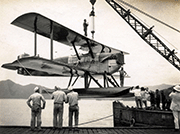E-Archive
Off the Beaten Track
in Vol. 19 - May Issue - Year 2018
Williwaws and Jackets

The aircraft Chicago

Changing from wheels to pontoons
The standoff lasted for a few seconds. The first man, wearing an elegant white suit and black bow tie, stood by the small lectern at the restaurant entrance and had just replied to the other man, an athletic figure dressed in slacks and a casual shirt.
The hopeful client changed tack. “Look, sir, I’m really sorry, but my friends and I don’t have jackets. Couldn’t you give us a table just the same?”
A frown appeared on the head waiter’s face as he slowly shook his head. “Our rules are very clear, Monsieur, all patrons must wear jackets.”
****
On a balmy Sunday morning in April 1924, four airplanes took off from a small airfield near Seattle, Washington. Their mission was to attempt the first circumnavigation of the world. By operating over long distances in extreme environments, it was hoped that the airplane’s practicality and value as a new technology could be proven. The U.S. Army Air Service (USAAS) organized the project and called it World Flight.
After considering various types of aircraft, the USAAS chose the Douglas World Cruiser. This aircraft was a single-propeller, two-seat biplane powered by a Liberty V-12 engine generating 420 hp. It was eleven meters long, four meters high and with a wingspan slightly over fifteen meters. Parts of the fuselage were made with steel tubes, while spruce wood was used for the wings and for other parts of the fuselage. The skin was made with cotton cloth, except for the engine cowling made with aluminum sheeting. Its top speed was about 160 km/h. It could be fitted with interchangeable wheeled and pontoon landing gear. The pontoon landing gear was necessary since the aircraft would be landing on the sea on many stopovers.
Each plane carried a crew of two and was named after a U.S. city representing a compass point: Seattle, Chicago, Boston and New Orleans.
The four planes flew up the coast of Canada to Alaska. While flying through thick fog in the Alaskan Peninsula, the aircraft Seattle crashed into a mountainside and had to abandon the project. Fortunately, the two crew members survived unscathed, but had to walk through the wilderness for ten days before being rescued. Braving freezing temperatures and storms, the three remaining aircraft flew down the length of Alaska’s Aleutian Islands. Here they encountered williwaws, sudden and violent blasts of cold air descending from mountainous coasts to the sea at high latitudes.
Across the North Pacific and on to Japan, Korea, the Chinese coast, Hong Kong and French Indochina. Due to a sudden engine breakdown, the Chicago was forced to land in the Gulf of Tonkin and had to be towed by paddle-powered sampans for ten hours to the nearest repair center. In the city of Saigon, the fliers were refused service at a restaurant because they were not wearing jackets!
During the months of June and July, the World Flight continued through Thailand, Burma, the Indian subcontinent and the Middle East. By the time they reached Europe, news of their enterprise had spread and the flyers were greeted by swarms of enthusiastic crowds at every stopover.
The flights from England to Iceland and then to Greenland were the longest sectors over water in the entire journey. Thanks to the fact that the U.S. Navy had positioned ships along the flight path, the crew of the Boston was rescued when their plane went down in mid-Atlantic.
Finally back on American soil, the pilots received a hero’s welcome in fourteen cities in nine states. They later confessed that they found the endless series of parades, speeches, receptions and banquets to be more tiring than the entire journey around the world.
The World Flight reached its official conclusion at Seattle on September 24th, 1924. The trip had lasted 175 days over a distance of 44,360 km, with stopovers in 69 cities. The actual total flying time was 371 hours and 11 minutes.
The ultimate success of the project was a result of meticulous planning. Spare parts and support equipment had been shipped around the world prior to the flight. The spare parts included thirty-five extra Liberty engines, fourteen sets of pontoons and enough airframe parts to build two more aircraft. There were even two sizes of radiators, the smaller ones to be installed when the aircraft were flying in cold climates and the larger ones for the warmer climates. Twenty-eight nations provided thousands of liters of fuel and oil. At predetermined locations, the aircraft had their engines changed five times and new wings fitted twice.
By Giovanni Gregorat, Contributing Editor MFN
Author: Giovanni Gregorat




























